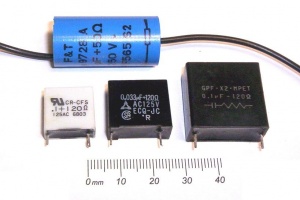Difference between revisions of "Snubber"
(couple trivials) |
(pic) |
||
| Line 1: | Line 1: | ||
A '''snubber''' is a small device that reduces switch arcing, thus avoiding premature switch failure. | A '''snubber''' is a small device that reduces switch arcing, thus avoiding premature switch failure. | ||
| + | |||
| + | [[image:Snubber.jpg|thumb|Snubbers]] | ||
==When to use a Snubber== | ==When to use a Snubber== | ||
Revision as of 15:22, 14 May 2008
A snubber is a small device that reduces switch arcing, thus avoiding premature switch failure.
When to use a Snubber
Snubbers are used with inductive loads which cause switch arcing. Examples of inductive loads:
- Motors
- Medium & large transformers
- Fluorescent Lighting with glow starters (these flash during starting)
When not to use a Snubber
A snubber compromises the degree of isolation a switch provides, so should only be used when required to ensure the switch continues to work properly. Hence the great majority of household switches don't have snubbers.
Component Values
The standard snubber is a 0.1uF capacitor and 100 ohm resistor in series, usually encased as one component. These values are good for the great majority of loads.
Low current loads and heavy loads may need different values. Heavy loads will need a larger capacitor and lower resistance. Low current loads may need smaller capacitor and higher resistance.
The snubber is simply connected across the switch.
Help
If you dont know whether to use one, you can ask us in news:uk.d-i-y.
For most switches they're not needed. When they are needed, repeated premature switch failure will occur if one is not fitted, as well as sparking and radio interference when switching.
